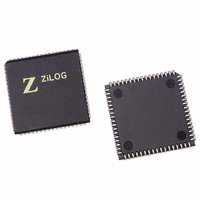Z16C3516VSG Zilog, Z16C3516VSG Datasheet - Page 248

Z16C3516VSG
Manufacturer Part Number
Z16C3516VSG
Description
IC 16MHZ Z8500 CMOS ISCC 68-PLCC
Manufacturer
Zilog
Series
IUSC™r
Specifications of Z16C3516VSG
Controller Type
Serial Communications Controller (SCC)
Interface
USB
Voltage - Supply
4.75 V ~ 5.25 V
Current - Supply
50mA
Operating Temperature
0°C ~ 70°C
Mounting Type
Surface Mount
Package / Case
68-LCC (J-Lead)
Lead Free Status / RoHS Status
Lead free / RoHS Compliant
Other names
269-4690-5
Z16C3516VSG
Z16C3516VSG
Available stocks
Company
Part Number
Manufacturer
Quantity
Price
Company:
Part Number:
Z16C3516VSG
Manufacturer:
INTEL
Quantity:
6 219
- Current page: 248 of 268
- Download datasheet (3Mb)
Application Note
On-Chip Oscillator Design
Pierce Oscillator (Feedback Type)
The basic circuit and loop gain is shown in Figure 1. The
concept is straightforward; gain of the amplifier is
A = Vo/Vi. The gain of the passive feedback element is
B = Vi/Vo. Combining these equations gives the equality
AB = 1. Therefore, the total gain around the loop is unity.
Also, since the gain factors A and B are complex numbers,
they have phase characteristics. It is clear that the total
phase shift around the loop is forced to zero (i.e., 360
degrees), since V
circuit, the amplifier ideally provides 180 degrees of phase
shift (since it is an inverter). Hence, the feedback element
is forced to provide the other 180 degrees of phase shift.
15-2
OSCILLATOR THEORY OF OPERATION (Continued)
C1
IC
Figure 2. Zilog Pierce Oscillator
IN
must be in phase with itself. In this
A
XTAL
C2
Additionally, these gain and phase characteristics of both
the amplifier and the feedback element vary with
frequency. Thus, the above relationships must apply at the
frequency of interest. Also, in this circuit the amplifier is an
active element and the feedback element is passive. Thus,
by definition, the gain of the amplifier at frequency must be
greater than unity, if the loop gain is to be unity.
The described oscillator amplifies its own noise at startup
until it settles at the frequency which satisfies the
gain/phase requirement AB = 1. This means loop gain
equals one, and loop phase equals zero (360 degrees). To
do this, the loop gain at points around the frequency of
oscillation must be greater than one. This achieves an
average loop gain of one at the operating frequency.
The amplifier portion of the oscillator provides gain > 1 plus
180 degrees of phase shift. The feedback element
provides the additional 180 degrees of phase shift without
attenuating the loop gain to < 1. To do this the feedback
element is inductive, i.e., it must have a positive reactance
at the frequency of operation. The feedback elements
discussed are quartz crystals and ceramic resonators.
Quartz Crystals
A quartz crystal is a piezoelectric device; one which
transforms electrical energy to mechanical energy and
vice versa. The transformation occurs at the resonant
frequency of the crystal. This happens when the applied
AC electric field is sympathetic in frequency with the
mechanical resonance of the slice of quartz. Since this
characteristic can be made very accurate, quartz crystals
are normally used where frequency stability is critical.
Typical frequency tolerance is .005 to 0.3%.
The advantage of a quartz crystal in this application is its
wide range of positive reactance values (i.e., it looks
inductive) over a narrow range of frequencies (Figure 3).
UM011001-0601
Related parts for Z16C3516VSG
Image
Part Number
Description
Manufacturer
Datasheet
Request
R

Part Number:
Description:
CMOS ISCC INTEGRATED SERIAL COMMUNICATIONS CONTROLLER
Manufacturer:
ZILOG [Zilog, Inc.]
Datasheet:

Part Number:
Description:
Communication Controllers, ZILOG INTELLIGENT PERIPHERAL CONTROLLER (ZIP)
Manufacturer:
Zilog, Inc.
Datasheet:

Part Number:
Description:
KIT DEV FOR Z8 ENCORE 16K TO 64K
Manufacturer:
Zilog
Datasheet:

Part Number:
Description:
KIT DEV Z8 ENCORE XP 28-PIN
Manufacturer:
Zilog
Datasheet:

Part Number:
Description:
DEV KIT FOR Z8 ENCORE 8K/4K
Manufacturer:
Zilog
Datasheet:

Part Number:
Description:
KIT DEV Z8 ENCORE XP 28-PIN
Manufacturer:
Zilog
Datasheet:

Part Number:
Description:
DEV KIT FOR Z8 ENCORE 4K TO 8K
Manufacturer:
Zilog
Datasheet:

Part Number:
Description:
CMOS Z8 microcontroller. ROM 16 Kbytes, RAM 256 bytes, speed 16 MHz, 32 lines I/O, 3.0V to 5.5V
Manufacturer:
Zilog, Inc.
Datasheet:

Part Number:
Description:
Low-cost microcontroller. 512 bytes ROM, 61 bytes RAM, 8 MHz
Manufacturer:
Zilog, Inc.
Datasheet:

Part Number:
Description:
Z8 4K OTP Microcontroller
Manufacturer:
Zilog, Inc.
Datasheet:

Part Number:
Description:
CMOS SUPER8 ROMLESS MCU
Manufacturer:
Zilog, Inc.
Datasheet:

Part Number:
Description:
SL1866 CMOSZ8 OTP Microcontroller
Manufacturer:
Zilog, Inc.
Datasheet:

Part Number:
Description:
SL1866 CMOSZ8 OTP Microcontroller
Manufacturer:
Zilog, Inc.
Datasheet:

Part Number:
Description:
OTP (KB) = 1, RAM = 125, Speed = 12, I/O = 14, 8-bit Timers = 2, Comm Interfaces Other Features = Por, LV Protect, Voltage = 4.5-5.5V
Manufacturer:
Zilog, Inc.
Datasheet:











